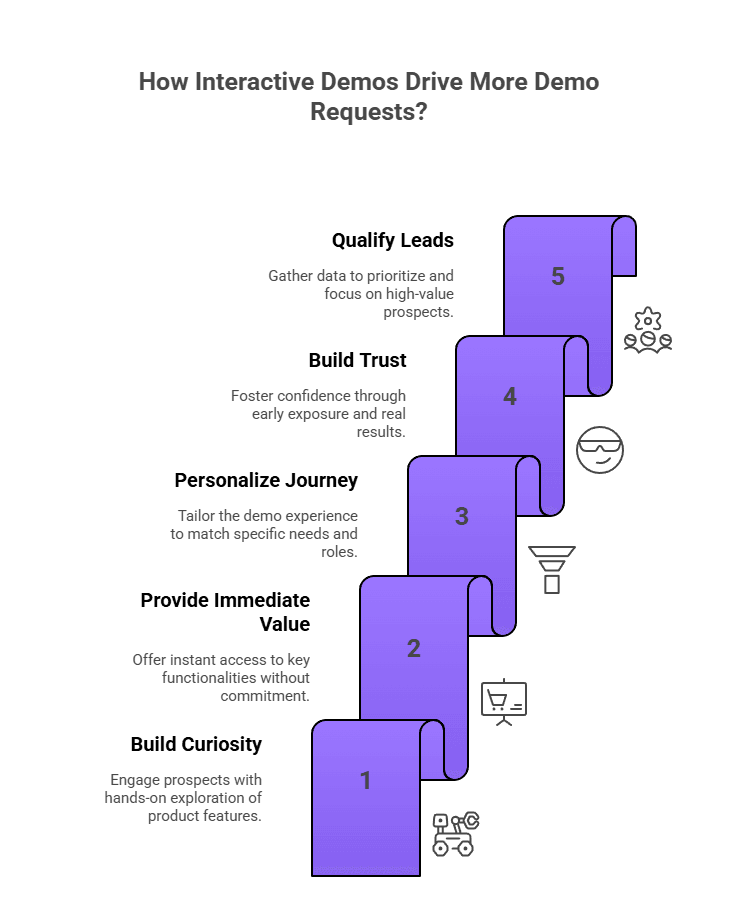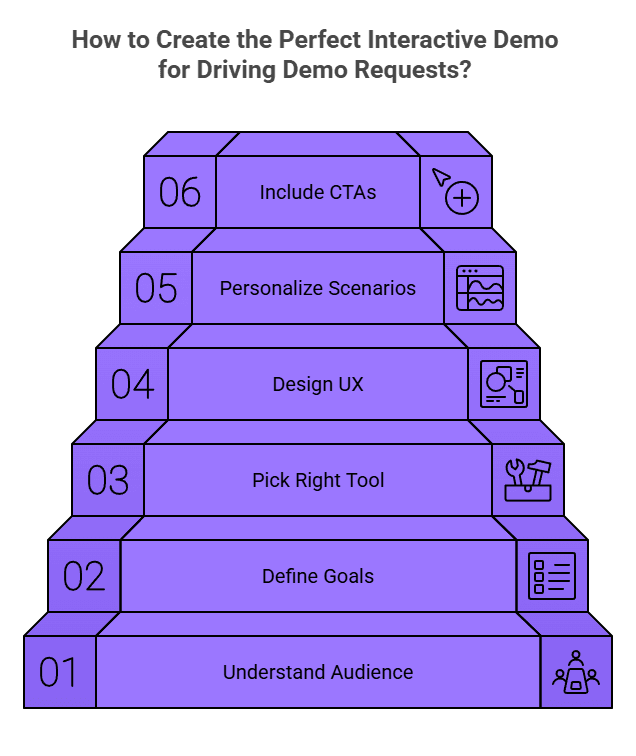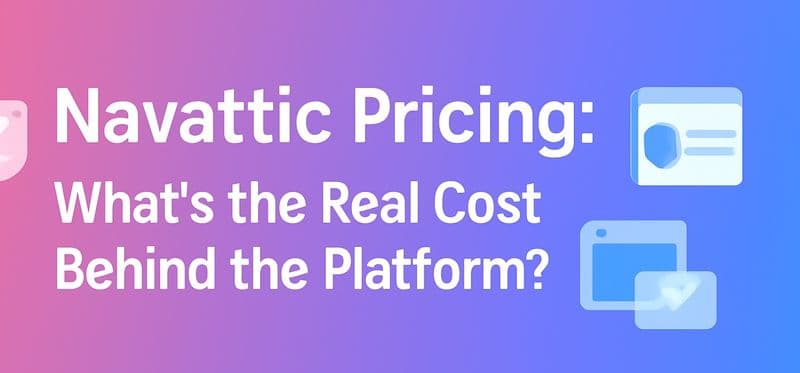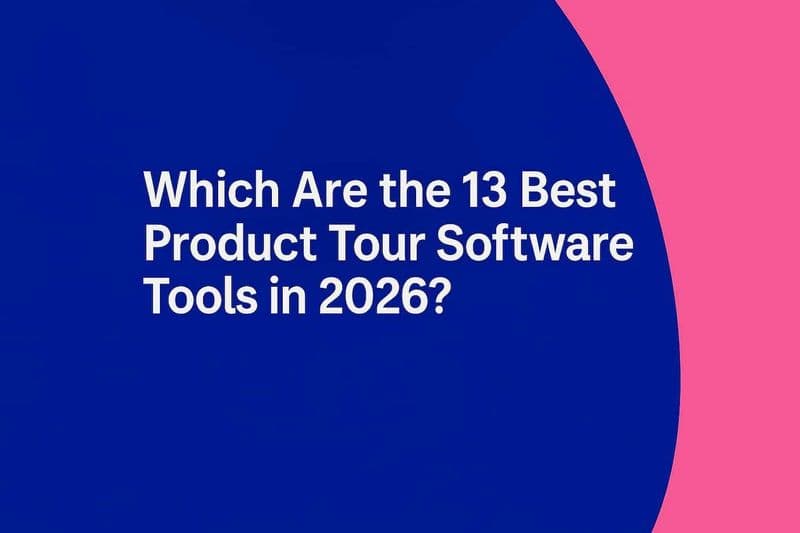
Key Highlights
Interactive demos let prospects explore products hands-on, boosting engagement and interest.
They show immediate product value, increasing the likelihood of demo requests.
Personalized and scenario-based demos make users feel understood and valued.
Prospects gain confidence and trust through self-guided, low-pressure experiences.
Analytics from interactive demos help sales teams prioritize high-intent leads.
The right tools and design make demos intuitive, memorable, and conversion-focused.
Getting prospects to commit to a live demo is tough. Many hesitate, fearing high-pressure sales calls or generic sessions that don’t address their specific needs. The result? Leads slip away, slowing sales and limiting growth. Interactive demos change this dynamic—by letting prospects explore your product on their terms, you demonstrate immediate value, build trust, and drive more demo requests.
The goal is to transform the demo experience from a passive presentation into an engaging, hands-on journey that captures attention and drives action. Enter - Interactive Demos. By giving prospects control over how they explore your product, businesses can demonstrate value immediately, build trust, and encourage users to request full demos.
In this blog, we’ll explore how interactive demos differ from traditional demos, the key benefits they provide, and practical strategies to create the perfect interactive demo that boosts demo requests. We’ll also highlight why using the right tools can make your demos more effective and conversion-focused.
What are Interactive Demos?
Interactive product demos are essentially self-guided walkthroughs that let prospects experience your product on their own terms. Unlike a passive video or a static screenshot, an interactive product tour allows users to click through key features and workflows as if they were using the live product.
This hands-on approach shows them exactly how your product looks, feels, and works without needing to schedule a call or sign up for a trial.
How Interactive Demos Differ from Traditional Demos?
Traditional demos and interactive demos may share the same goal of showcasing a product, but the way they deliver value and engage the audience is quite different. Here are the key differences between the two approaches:
Aspect | Traditional Demos | Interactive Demos |
|---|---|---|
Presentation Style | Linear, presenter-led walkthrough | Hands-on, user-driven exploration |
Engagement Level | Passive listening and observation | Active participation with real-time interaction |
Customization | Generic, one-size-fits-all demo | Tailored to specific use cases and buyer needs |
Learning Experience | Limited understanding from watching | Deeper learning through direct product usage |
Flexibility | Predefined flow with little deviation | Adaptive flow based on user choices and questions |
Impact on Buying Decisions | Provides surface-level product overview | Builds confidence by letting buyers experience value firsthand |
Want some inspiration for creating your own interactive demos? Steal these 10 Interactive Product Demo Examples for Success to see what works best.
What are the Main Benefits of Using Interactive Demos for Increasing Demo Signups?
Here are some of the key benefits of using interactive demos if your goal is to improve demo signups:
Higher engagement: Prospects actively explore features instead of passively watching a presentation.
Immediate value demonstration: Users experience the product’s benefits upfront, encouraging demo signups.
Personalized experience: Tailored scenarios make prospects feel understood and relevant.
Trust and confidence building: Hands-on exploration reduces skepticism and promotes commitment.
Lead pre-qualification: Interaction data helps identify high-intent prospects for focused follow-up.
Shorter sales cycles: Prospects who engage with interactive demos are more likely to convert faster.
Want to see how interactive demos enhance customer onboarding. Check out this guide.
How Do Interactive Demos Lead to More Demo Requests?

Interactive demos are transforming how prospects engage with products. Unlike traditional demos, where buyers passively watch a presentation, interactive demos put them in control. Here are some ways in which interactive demos drive more demo requests:
1. Builds Curiosity Through Hands-On Exploration
Interactive demos give prospects the freedom to explore key product features at their own pace. Instead of following a linear, presenter-led walkthrough, users can click, test, and navigate features that interest them most. This active engagement helps them identify real-world applications of the product and visualize how it can solve their specific challenges.
As a result, prospects become genuinely invested in the experience and are more likely to reach out for a full, live demo to see the complete functionality in action.
2. Provides Immediate Value Without Commitment
Interactive demos let prospects experience your product instantly, removing friction and speeding up demo requests. Prospects quickly realize whether the product meets their needs, which naturally increases their interest in a full demonstration. This “try-before-you-buy” approach builds confidence and creates a sense of urgency to explore the product further with the sales team.
For example, an analytics brand creates a sandbox demo where users upload sample data and generate instant reports. As the prospect sees immediate insights tailored to their business, it motivates them to schedule a live demo to see more sophisticated reporting features.
3. Personalizes the Buyer’s Journey
Unlike generic, one-size-fits-all demos, interactive demos can be tailored to different industries, roles, or use cases. For example, a marketing manager may explore analytics features, while a sales director focuses on pipeline management tools.
This personalization signals to prospects that the company understands their unique needs and is willing to provide relevant solutions. Feeling seen and valued significantly increases the likelihood that prospects will request a customized, live demo to dive deeper into their specific requirements.
4. Builds Trust and Confidence Early
Interactive demos allow prospects to experience the product firsthand in a low-risk environment. When they can explore features and see real results early on, skepticism diminishes. This early exposure fosters trust and reassures prospects that the product delivers on its promises.
As a result, they are more confident in committing time to a live demo, knowing it will provide further actionable insights rather than just another generic presentation.
5. Creates a Stronger Lead Qualification Funnel
Every interaction within an interactive demo provides valuable data for sales teams. By tracking which features prospects explore, how long they spend on different sections, and where they encounter challenges, teams can gauge interest levels and intent. This insight allows sales representatives to prioritize high-value leads, tailor follow-up conversations, and focus demo sessions on areas that matter most to the prospect.
For example, an interactive demo for an HR platform tracks which features a prospect explores: payroll automation or performance management. The sales team sees that the prospect spends most time on performance tools and follows up with a customized demo focused solely on those features, increasing the chance of conversion.
How to Create the Perfect Interactive Demo for Driving Demo Requests?

Creating an interactive demo that truly drives demo requests requires careful planning, thoughtful design, and an understanding of your audience’s needs.Here’s a step-by-step approach to creating the perfect interactive demo.
Step 1: Understand Your Audience and Their Pain Points
The first step in designing an effective interactive demo is to know who will be using it. Identify the target personas, their challenges, and what outcomes they care about most. By aligning your demo around these pain points, you ensure that prospects immediately see relevance and value.
For example, a finance manager might focus on automation and reporting features, while an operations lead may explore workflow optimization tools. Tailoring the demo to address these specific needs increases engagement and the likelihood of demo requests.
Step 2: Define Clear Goals and Key Features to Showcase
Before building the demo, outline what you want to achieve and which product features to highlight. Focus on the functionalities that directly solve your prospects’ problems or differentiate your product from competitors.
Avoid overwhelming users with every feature; instead, guide them toward the most impactful areas. Clear goals help ensure that the demo delivers a compelling, memorable experience that encourages prospects to take the next step.
Step 3: Pick the Right Tool
Choosing the right platform or tool to build your interactive demo is crucial. The tool should support user-friendly interactivity, easy customization, and analytics tracking to measure engagement. It should also integrate with your CRM or marketing automation system to capture leads and follow up efficiently.
The right tool not only ensures a smooth demo experience but also maximizes the number of qualified demo requests generated.
Step 4: Design an Intuitive and Engaging User Experience
The success of an interactive demo depends heavily on how easy and enjoyable it is to use. The interface should be intuitive, visually appealing, and interactive without being confusing. Include guided tours, tooltips, and contextual instructions to help users explore features without frustration.
A seamless experience keeps prospects engaged longer, increases their understanding of the product, and naturally leads them to request a live demo for deeper exploration. Don't forget to ask for feedback after the demo. It shows that you care for their valuable input. If you are wondering how to use customer feedback to improve interactive product demos, check out this guide.
Step 5: Include Personalization and Scenario-Based Use Cases
Interactive demos are most effective when prospects can relate the product to real-world scenarios. Incorporate role-specific workflows, sample data, or pre-configured use cases that mirror how the product will be used in their environment.
Personalization makes the experience relevant, demonstrates practical value, and helps prospects envision the impact of the product on their day-to-day operations, which are key factors in prompting demo requests.
Step 6: Provide Clear Calls-to-Action Throughout the Demo
An interactive demo should not only educate but also guide prospects toward taking action. Include strategically placed CTAs encouraging users to schedule a live demo or speak with a sales representative.
Whether it’s a “Book Your Full Demo” button after completing a feature walkthrough or a prompt to request a customized session based on their activity, clear calls-to-action make it easy for prospects to take the next step.
Why Smartcue Leads the Pack in Interactive Demo Software?
Smartcue stands out in the race for the best interactive demo software as it empowers sales and marketing teams to create highly personalized, engaging product experiences that captivate prospects. The platform's no-code interface makes building complex interactive demos fast and accessible, while robust personalization ensures each prospect receives a relevant experience tailored to their role, industry, or use case.
Seamless integrations with tools like Salesforce and HubSpot, combined with detailed analytics on engagement and interactions, help teams optimize their demo strategy and improve conversion rates.
With rapid deployment and a focus on both efficiency and user experience, Smartcue provides a comprehensive solution that consistently helps organizations accelerate sales cycles and turn leads into qualified opportunities. Want to experience Smartcue first-hand? Sign up for a free 14-day trial now.
Turn Curiosity into Conversions with Interactive Demos
Interactive demos are more than just a flashy way to showcase your product. They are a strategic tool that drives engagement, builds trust, and accelerates the sales process. By giving prospects control over their demo experience, providing personalized scenarios, and capturing actionable insights, businesses can transform casual visitors into highly qualified leads. Whether it’s increasing demo requests, shortening sales cycles, or improving lead qualification, the power of interactive demos is undeniable. Embracing this hands-on, user-focused approach ensures your product stands out, resonates with buyers, and ultimately converts curiosity into measurable business growth.
Frequently Asked Questions
How do interactive demos influence user decision-making?
Interactive product demos influence decision-making by offering a transparent, hands-on look at a product's value proposition. This high user engagement builds trust early in the sales cycle, giving prospects the confidence they need to move forward. This experience leads to a higher conversion rate because users have already validated the product for themselves.
Can interactive demos help qualify leads before a live demo request?
Yes, absolutely. An interactive product tour acts as a filter, as prospects can determine if the solution fits their needs. Those who complete a tour and request a demo are highly qualified leads with strong intent, allowing sales teams to focus their efforts on the most promising opportunities and improving activation rates.
What are some best practices for creating effective interactive demos?
Best practices include personalizing content for buyer personas, keeping the user experience simple, showing key product features, and gathering data for insights. A strong demo strategy aligns product marketing goals with customer success by creating a helpful, engaging experience that clearly communicates value from the start.
What metrics should be tracked to measure the success of interactive demos?
Key metrics to track include demo engagement, click-through rates, and completion rates. You should also monitor the conversion rate from demo viewer to live demo request. These analytics provide insight into the overall demo experience and help you identify areas for improvement to drive better results.
Are there any specific industries that benefit more from using interactive demos?
While many industries can benefit, B2B SaaS companies, particularly in complex fields like project management or marketing automation, see immense value. Case studies show that any business with a digital product can use interactive demos to showcase new features and explain their value proposition more effectively than static content.
What statistics show the effectiveness of interactive demos for capturing leads?
While there are no specific data around capturing leads per se, there are data points showing the effectiveness of interactive demos in general. For instance, one study states that interactive demos actually increase the chance of generating MQLs by 63%.
Can you explain the strategies that use interactive demos to boost demo requests?
Strategies include offering hands-on product tours, personalizing demos for specific buyer roles, using scenario-based workflows, placing clear calls-to-action, enabling self-guided exploration, and tracking engagement data to identify high-intent prospects for follow-up and demo scheduling.
Are there real-world examples of companies increasing demo requests with interactive demos?
Yes, absolutely. Many companies have seen a significant boost in demo requests using interactive demos. You can explore real-world success stories from organizations that partnered with us and transformed their onboarding and sales experiences through interactive product tours in our case study section.


